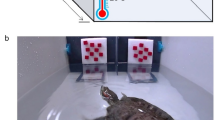Summary
A population of eight juvenile female yellow-bellied marmots (Marmota flaviventris) was introduced into a marmot locality from which all other marmots were removed. Social interactions were monitored in the field and the individual behavioral profile of each animal was determined by mirror image stimulation. Social interactions were unequally distributed among the eight juveniles. Neither body size nor kinship were significantly related to frequencies of social interactions. Social interactions were significantly related to individual differences.
Similar content being viewed by others
References
Archer J (1970) Effects of population density on behaviour in rodents. In: Crook JH (ed) Social behaviour in birds and mammals. Academic Press, New York, pp 169–210
Armitage KB (1962) Social behaviour of a colony of the yellow-bellied marmot (Marmota flaviventris). Anim Behav 10:319–331
Armitage KB (1974) Male behaviour and territoriality in the yellow-bellied marmot. J Zool 172:233–265
Armitage KB (1977) Social variety in the yellow-bellied marmot: A population-behavioural system. Anim Behav 25:585–593
Bekoff M (1977) Mammalian dispersal and the ontogeny of individual behavioral phenotypes. Am Nat 111:715–732
Bekoff M (1981a) Vole population cycles: kin-selection or familiarity? Oecologia (Berl) 48:131
Bekoff M (1981b) Mammalian sibling interactions. Genes, facilitative environments, and the coefficient of familiarity In: Gubernick D, Klopfer PH (eds) Parental behaviour in mammals. Plenum, New York, pp 307–346
Charnov EL (1981) Vole population cycles: Ultimate or proximate explanation? Oecologia (Berl) 48:132
Charnov EL, Finerty JP (1980) Vole population cycles: A case for kin-selection? Oecologia (Berl) 45:1–2
Gaines MS, McClenaghan LR Jr (1980) Dispersal in small mammals. Annu Rev Ecol Syst 11:163–196
Krebs CJ (1978) A review of the Chitty hypothesis of population regulation. Can J Zool 56:2463–2480
Nowicki S, Armitage KB (1979) Behavior of juvenile yellow-bellied marmots: Play and social integration. Z Tierpsychol 51:85–105
Porter RH, Wyrick M (1979) Sibling recognition in spiny mice (Acomys cahirinus): Influence of age and isolation. Anim Behav 27:761–766
Sampson RJ (1975) Surface II graphics system. Kans Geol Surv (Lawrence)
Schwartz OA, Armitage KB (1980) Genetic variation in social mammals: The marmot model. Science 207:665–667
Svendsen GE (1974) Behavioral and environmental factors in the spatial distribution and population dynamics of a yellow-bellied marmot population. Ecology 55:760–771
Svendsen GE, Armitage KB (1973) An application of mirror-image stimulation to field behavioral studies. Ecology 54:623–627
Author information
Authors and Affiliations
Rights and permissions
About this article
Cite this article
Armitage, K.B. Social dynamics of juvenile marmots: Role of kinship and individual variability. Behav Ecol Sociobiol 11, 33–36 (1982). https://doi.org/10.1007/BF00297663
Received:
Accepted:
Issue Date:
DOI: https://doi.org/10.1007/BF00297663




